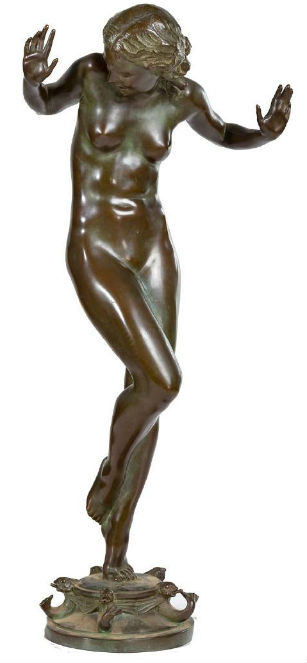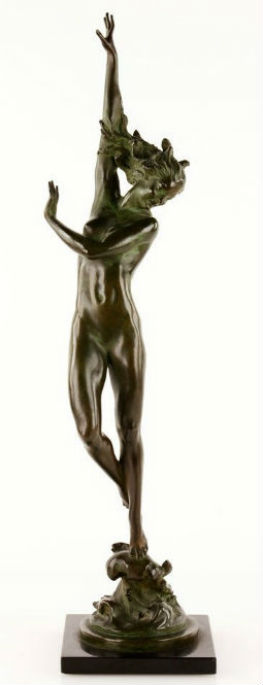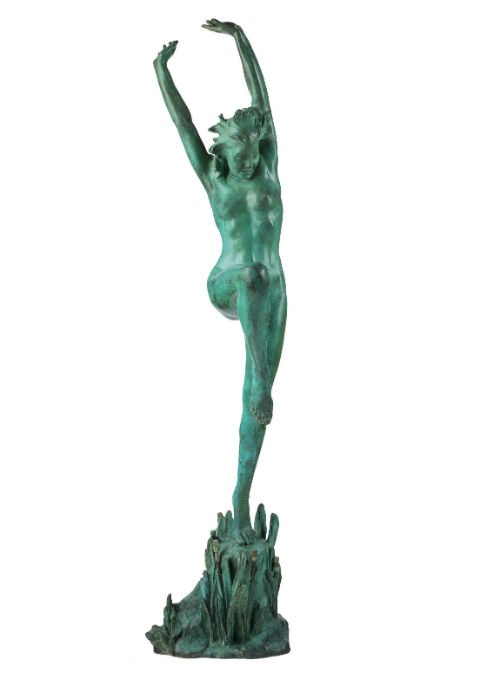
NEW YORK – The sensuality of the female form in sculpture, especially bronze, was arguably never as adeptly captured as in the works of American sculptor Harriet Whitney Frishmuth (1880-1980). Her lyrical sculptures, especially of dancers, are renowned for capturing the subject’s movements and every muscled or graceful curve and line.
Her larger-than-life works grace the permanent collections of many fine museums and are eagerly sought-after by private collectors. For years, smaller versions of her works in bronze, produced for decades at the Gorham Foundry in Providence, R.I., were in many American homes as decor objects. She also used Roman Bronze Works in New York City for castings. Eminently collectible also, they are, at last, gaining increased attention in recent years as well as the scholarship they are due. A 2006 book, Captured Motion: The Sculpture of Harriet Whitney Frishmuth, A Catalogue of Works, was the first comprehensive look at the artist’s life and her body of work with many color illustrations and details on the 150+ sculptures she produced.

Among Frishmuth’s most famous monumental bronzes is The Vine, 83½ inches tall (smaller statuette castings were also made), in the collection of the Metropolitan Museum of Art since 1927, and which was exhibited at the New York World’s Fair in 1964-65. The piece was first made in 1924. The museum’s casting dates to 1924.
The work is part of a larger body of her works focusing on dancing women, which in the early 20th century was a popular motif in sculpture, popularized by Frishmuth, Isadora Duncan and other artists. The sitter for this work and many of Frishmuth’s works depicting female nudes was the dancer Desha Delteil of the Fokine Ballet.
“Shown stretching upward and outward in imitation of a living vine, this lyrical nude balances on tiptoe in the ecstasy of performance, a grapevine suspended in her hands,” according to commentary on the Met museum’s website. This work was first made as a statuette standing just over 11 inches high. The nearly 400-piece edition sold so well Frishmuth cast massive versions, one of which is in the museum.

“Frishmuth’s bronzes epitomize the advice of her former teacher Auguste Rodin, who suggested that successful figures were composed where ‘… movement is the transition from one attitude to another. It is a bit of what was and a bit of what is to be.’ This quality, the arresting of motion, continues to make her sculpture appealing to contemporary collectors,” said David L. Prince, curator, SUArt Galleries, Syracuse (N.Y.) University.
Desha Deltail (nee Podgorski, 1895-1965) was a Yugoslav-born interpretive dancer who trained with Mikhail and Vera Fokine. “Desha’s specialty as a dancer was performing with large bubbles. Her popularity as a model stemmed from her ability to hold poses for extended periods of time and while she posed for several sculptors, she became particularly associated with Frishmuth,” Prince said.

One example of Frishmuth’s sculptures featuring Desha posing with bubbles is The Bubble, which is on display at the Crystal Bridges Museum of American Art in Bentonville, Ark. The larger-than-life 1928 sculpture stands 94 inches tall. Noting that many of Frishmuth’s models were dancers, both men and women, the museum commented on its website, “Their lean, athletic bodies and ability to hold difficult poses for an extended length of time allowed Frishmuth to create sculptures that celebrated the beauty of the human form and captured the vitality of the American spirit.”
While Frishmuth was unquestionably the artist and the driving force behind her art, there was a spirit of collaboration between her and her models. In Slavonic Dancer, which depicts Leon Barte, also of the Fokine Ballet, he is reported to have advocated for the very muscular and physical nature of his pose shown in the final work. Form and lines contrast beautifully here and the nature of bronze as a medium reproduces his athletic body to perfection.

The medium of bronze was well suited for Frishmuth’s work, enabling her to capture the details of the human form as well as achieving a wonderful patina as the fused metals reacted chemically. She is known to have been an avid experimenter, working closely with the foundries producing her casts to ensure the patina was to her satisfaction. Early examples mostly had a reddish-brown patina but in later years, she favored a signature green tint.
As with nearly all types of antiques, reproductions and fakes abound and with bronzes, it can be exceedingly difficult to determine the authenticity of a bronze cast. Provenance is key but in the absence of irrefutable documentation, one can look at the quality of the bronze by inspecting its seams, joints, overall casting and chasing quality, its thickness and weight as well as comparing its measurements to known examples from castings made during the artist’s lifetime of a particular piece. If the piece measures smaller than what is expected, it was likely cast from another bronze rather than from the original mold. As always, do your homework and seek out experts as needed.
# # #


